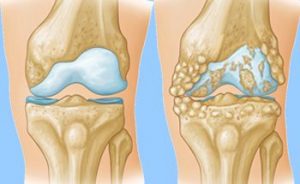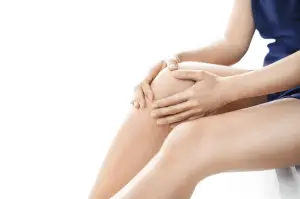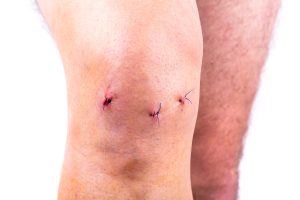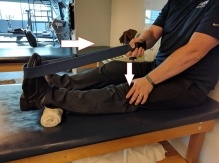 A loss of knee extension is a common issue many encounters after a surgery or a severe injury. Knee extension is the act of getting the knee as straight as possible. Achieving full knee extension is one of the first goals one wants to push for after surgery. Getting that full motion back is also a critical determinant of long term success after undergoing surgery. You will notice the physical therapist or the surgeon checking on the progress of your knee extension frequently. There are many different potential causes for a loss of knee extension including swelling, hamstring tightness, quad weakness, and tightness in the joint capsule.
A loss of knee extension is a common issue many encounters after a surgery or a severe injury. Knee extension is the act of getting the knee as straight as possible. Achieving full knee extension is one of the first goals one wants to push for after surgery. Getting that full motion back is also a critical determinant of long term success after undergoing surgery. You will notice the physical therapist or the surgeon checking on the progress of your knee extension frequently. There are many different potential causes for a loss of knee extension including swelling, hamstring tightness, quad weakness, and tightness in the joint capsule.
In a normal knee, there are often a few degrees of extension beyond zero. The last few degrees of motion are the most important as that is when the screw-home mechanism occurs. This is a rotation by the femur and tibia to further stabilize the joint. This makes the joint snug and tight and requires minimal muscular effort to hold the joint tight.
Why is Knee Extension Important
Achieving full knee extension after surgery is often the first and most important goal after any surgery due to the importance that the fully locked extension gives us. Listed below are some of the risks if full knee extension is not achieved.
Increases Risk of Knee arthritis
 Due to the fact that the knee never fully gets straight, it can cause an increase in the rate of developing knee arthritis. The force and loads of normal activity are now focused on a smaller area and cause quicker deterioration of that cartilage. Over time this starts to cause more wear and tear build-up creating problems including pain and limited range of motion.
Due to the fact that the knee never fully gets straight, it can cause an increase in the rate of developing knee arthritis. The force and loads of normal activity are now focused on a smaller area and cause quicker deterioration of that cartilage. Over time this starts to cause more wear and tear build-up creating problems including pain and limited range of motion.
May Cause Permanent Weakness in the Knee
When the knee can no longer get straight it puts the quadricep muscles in a weird position. They no longer have their full motion to work. More importantly, they never truly get to rest because the knee is always partially bent. The quads now have to work all the time to keep you from collapsing as opposed to the normal locking mechanism of a healthy knee. This can cause muscle inhibition or a permanent fatigue factor.
Potentially a Worse Outcome After Surgery
If your knee does not get straight or nearly straight then you may be worse off than if you didn’t have surgery at all. The long term discomfort of having a bent knee could make your functional ability less than what you had previously. Those goals of walking, hiking, or biking more may be even harder now.
Can Lead to Patella Tendonitis
 The patella tendon comes over the top of the knee cap and connects the quadriceps muscles to the shin bone. If the knee is unable get fully straight then this powerful tendon must always be “on.” Due to always have to be “on” and working the tendon is constant loaded with more tension than it is designed to tolerate. This may lead to patella tendonitis with pain, microtrauma, and weakening of the tendon in the long term.
The patella tendon comes over the top of the knee cap and connects the quadriceps muscles to the shin bone. If the knee is unable get fully straight then this powerful tendon must always be “on.” Due to always have to be “on” and working the tendon is constant loaded with more tension than it is designed to tolerate. This may lead to patella tendonitis with pain, microtrauma, and weakening of the tendon in the long term.
Can Lead to Changes in Gait Pattern
Without full knee extension, the knee cannot achieve the final position needed for walking. This may cause someone to walk with a bent knee and more compensations from the hip. This creates a chronic limp. This may not seem like a big deal if there is no pain, but in the long term, this can cause problems in the hips and low back. Now you have a stiff knee and back issues to deal with.
What Causes A Loss of Knee Extension
There are many different reasons for the loss of knee extension. It’s often not just one reason but many of the reasons may happen at once. See the different causes listed below.
Joint Swelling
Swelling and inflammation are some of the most common reasons that the knee can’t get fully straight. The extra fluid fills up the limited joint space and increases the pressure within the knee joint. This creates pain and discomforts the closer to full extension the knee gets. Swelling can also temporarily shut muscles “off.” If the muscles around the knee, particularly the quadriceps, is working at full capacity as you’ll see below this also further complicates the situation.

Hamstring Tightness/Knee Contracture
After an injury or surgery, the hamstrings will often try to protect the knee joint and shorten to a guarded position. If this happens over a long period of time the knee and hamstring muscles and knee joint will forever stay that way. This may require a manipulation under anesthesia or diligent long term stretching to get the knee straight again.
Joint Capsule Limitation
The knee joint capsule is the surrounding ligaments, tendons, and soft tissue to cover the knee joint. It separates the knee from the other areas of the inside of the body to prevent infection and maintain the pressure for proper lubrication. The ligamentous capsule can shorten due to various reasons and cause movement restriction. This may also require manipulation or surgical intervention to remove the built-up scar tissue.
Quad Weakness
The quadriceps muscle is a group of 4 muscles that work together to straighten the knee and keep us upright. After surgery, the increase in pain and swelling will temporarily turn off the quad muscle. Now the primary muscle responsible for getting the knee straight can no longer perform that job. The quad is responsible for 60% of the function of the knee overall.
The Best Exercises To Get The Knee Straight After Surgery
The following exercises are all designed to help you get the knee straight. Collectively they address the various reasons that cause a lack of knee extension. It’s best to do them as a group and after using a hot pack or a good warm-up.
Push/Pull Knee Extension Stretch
This exercise is great because it uses both active and passive stretching techniques. Start by sitting up with a stretching strap on your foot and your legs straight out in front of you. Then squeeze your thigh muscles to push your knee down. Next, pull the strap on your foot towards you to pull the foot and leg into more extension. You will want to hold this at least 10 seconds during each rep if not for longer.

Quadriceps Sets with a Heel Lift
The quad set exercise is a classic exercise during any knee recovery process. To get the most benefit, place a half foam roller or a rolled-up towel underneath your ankle. Now let your knee passively straighten as much as it can before squeezing your quad or thigh muscles as hard as you can. You want to imagine you’re driving your knee towards the ground. Try and hold this for 6 seconds or longer to improve overall muscle activation. Note that squeezing your quad may be difficult right after surgery but keep practicing and each day it will get easier. We recommend starting in a sitting position to give the thigh a better chance of working. You can do these all day long to help get the knee straight.
Terminal Knee Extensions
The terminal knee extension exercise is a great way to work on knee extension in standing position and to get your quad muscle stronger at the same time. Start by stepping into a resistance band or a Theraband and placing it behind the knee. Anchor the other end to a closed-door or around a sturdy object. Stand with the target knee bent and voluntarily squeeze your thigh muscle and try to straighten your knee without moving your foot. Again try to hold the knee straight for 5-6 seconds and then release. Shoot for 20-30 reps depending on pain and fatigue.
Seated Prolonged Knee Extension with Weight
The Seated Knee Hang exercise is a great way to improve extension in knees that have had a difficult time getting time straight. This exercise stretches the hamstrings, knee capsule, and is great for knees that “have a build-up of too much scar tissue.” Start by sitting upright in a chair with a coffee table or another chair in front of you. Put your heel on the other chair and let your knee hang between with gravity pushing your leg down to the floor. Depending on how long it has been since surgery you may need to place an ankle weight on your knee to get more of a stretch. You don’t want too much weight or your hamstring muscle will turn on and start to guard making it nearly impossible to get much straighter. We recommend a 5 and/or a 10 lb ankle weight. Try and sit in this stretch for 5- 10 minutes depending on tolerance to induce tissue creep (link) and long term gains.
Hamstring Fatigue Exercises
One of the most common reasons for knee tightness is hamstring spasm/guarding/tightness. This is especially common after surgeries such as ACL surgery. So one of the best ways to fix this is to fatigue your hamstrings to let go and relax. Start by lying on your stomach. You can use a partner or use your other leg to be the resistance piece. While lying on your stomach try to bend your knee towards your hips but use your other leg to prevent the surgical leg from moving. This is an isometric exercise that should be performed in a pain-free position. Hold for 5 seconds and you want to do as many as can you get the hamstring completely tired. Once the hamstring is tired out, this is a perfect time to do some of the other stretches without the hamstring jumping in to restrict.
A Note About Prone Knee Extension Hangs
One of the exercises that haven’t been mentioned yet is prone knee hangs. During this exercise, you lie on your stomach with your knee off the edge of the bed and allow gravity to straighten your leg. While this is a commonly prescribed exercise in many physical therapy clinics, it’s not one of our favorites. While it can be an effective exercise, it is really easy to compensate. It’s common for the hip to bend or roll to take the pressure off the knee as a compensation. Also, this exercise commonly creates MORE hamstring activation and guarding to prevent gravity from causing more discomfort.
Conclusion
Knee extension is one of the most important motions to regain after surgery. Without gaining full knee extension there is a risk for developing problems down the road. With the different causes of a loss of knee extension, it’s important to work on extension consistently and frequently. The above exercises help address each of the causes and will help in the recovery after surgery.
Works Referenced
https://www.ncbi.nlm.nih.gov/pmc/articles/PMC1166437/pdf/janat00190-0184.pdf
Loss of Knee-Extension Strength Is Related to Knee Swelling After Total Knee Arthroplasty – The relationship between peak knee extension at heel-strike of walking and the location of thickest femoral cartilage in ACL reconstructed and healthy contralateral kneesExperimental Knee Pain Reduces Muscle Strength
Quadriceps Activation Following Knee Injuries: A Systematic Review
Disclaimer: The information provided in this post is for educational purposes only. This is not a substitute for a medical appointment. Please refer to your physician before starting any exercise program.






Comments are closed.